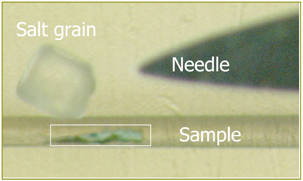Project

Painting layer is applied to a large variety of objects on various supports: wood, textiles, parchment, paper, metals, stone, ceramic, coatings and glass. Each one is part of a specific technological and artistic tradition. However, all these art or archaeological objects can be studied following the same methodology: the stratigraphic examination and the analyses which aim at identifying the materials used and the various phases of the production and the use of these objects:
• obtaining the raw materials (techniques of extraction, sources, exchanges,…)
• methods of preparation of the raw materials (washings, crushings, sifting, spinning,…),
• manufacturing processes of the object, itself, (molding, fusion, cooking,…),
• gestures of the artist in the execution of each phase of manufacture,…
The problems on these objects concern in particular the history of the techniques. What are the materials used? From where do these matters come from? What are the possible sources of exploitation and what are the possible structures and exchange relations for each time period and for each type of object?
Comparative analytical studies can help to understand the exchange of know-how between different cultures and/or periods, and to determine innovations and products introduced after the assimilation of a technique.
Preparation and analysis of model samples:
For better apprehending the technical processes used in art and their degradation, the experimental approach is impossible to avoid. Although the analyses of art objects give precise information on the identification of the materials and reveals important aspects of the techniques, the experimentation makes it possible to look further into these aspects and to evaluate the importance of each technological process. For example, in the reconstitution of the receipts of pigments, which parameters in the processes are essential to improve their qualities? The analyses carried out on the experimental samples also help to have better interpretation of the analyses made on works of the collections (identification of the matter residues used in the various stages of manufacture, possible source of the raw materials, the studies of the traces of tools,…).
For example, in the case of organic pigments and dyes, the lack of references is one of the problems to improve the possibilities of identification. The red organic pigments are studied quite well, but the yellow ones present still an analytical problem. The reconstitution of receipts with known products would allow in addition to better approaching the techniques, to have material data by several techniques and methods of analysis like Raman and infra-red spectroscopies.
Analysis of objects
The study of the painting technique involves not only the study of the stratigraphy (the way the painting layers are built up, a 3D image of the painting), but also the identification of the different artistic materials used like pigments, dyes and binding media.
There are two ways to analyze the pictorials layers : micro samplings and direct analysis.
Micro samplings
The micro sample, often not bigger than a pinhead and weighing less than 10 µg is embedded in a synthetic resin and polished. In many cases, this micro-sampling present less risk than transportation of the work of art (very large objects). Using optical microscopes with white polarized light or UV-light and digital cameras an image of the cross-section can be recorded. This is often the first and one of the most important steps in comprehending the technique used by the artist. The different painting layers, as well as the ground layer, isolation layers, metal leaves and varnishes all become visible. Some pigments can already be characterized by looking at their shape, colour and granulometry, but to really identify all materials used, combining multiple techniques is inevitable.
The cross-sections are also used for non-destructive analyses, in the sense that all measurements are done on the same cross-section.
Often scanning electron microscopy coupled to an energy or wavelength dispersive X-ray detector (SEM-EDX or -WDX) is used to quickly get atomic information. An excellent spatial resolution is obtained and mapping possibilities exist, allowing to visually render an image of the different elements present in the cross-section. In contradiction to SEM-EDX or -WDX molecular information can be obtained using micro-Raman spectroscopy (MRS). Also the analysis of organic pigments becomes possible, although due to fluorescence not all organic pigments or dyes can be determined. Thanks to sensitive deep depletion CCD detectors and intense and stable near infrared lasers, fluorescence can in many cases be avoided or limited. In the classic set-up a microscope is used to guide the laser to the cross-section and the induced Raman-signal to the spectrometer.
Time-of-Flight Secondary Ion Mass Spectrometry (ToF-SIMS) is 10 –100 x more sensible than SEM-EDX, so it allows analyzing and mapping the major, minor and trace level of components and at the same time providing isotopic information. Also the analysis of organic material is in principle possible by this technique.
Molecular and structural information on these micro-samples can be obtained by the use of synchrotron radiation techniques (XAS – X-ray Absorption Spectroscopy and X-ray diffraction).
Finally also for chromatographic analyses with GC-MS, LC-DAD and LC-MS micro-samples are required. As stated before the samples are consumed during analyses, but detailed information on the compounds present, in the form of chromatograms and (mass)spectra, is obtained.

Example of a micro-sample
Direct analysis
The analysis of the pictorial layers of easel paintings still raises many questions particularly if we wish to work without taking samples or by reducing the number of them. Indeed, the authorization to take is often obtained only when analyses were directly in relation with the restoration of the painting. Consequently the development of methods of analysis without samples is an important issue for the technological study of easel paintings. It is often the only possibility to study the painting not being in restoration.
The Raman Micro Spectrometry can be applied directly on a work of art without sampling.
This can be done using optical fibres and an optical head replacing the microscope, or by using portable MRS-instruments. Also portable X-ray fluorescence (XRF) instruments, leading again to atomic information of inorganic compounds, have over the last years emerged. Using optical fibres and/or portable instruments, size limitations are by-passed and even non-moveable works of art can be non-destructively analyzed. However only surface information is obtained.
Ion beam analysis techniques such as PIXE, PIGE and RBS are widely used in art and archaeology because of its great advantages (non-destructive, fast, high sensitivity multi-element detection and layer information).
We will present now examples of problems where the imaging and the analytical techniques can bring decisive answers. This research will be done in collaboration with art historians and archaeologists from different institutions (e.g. KIK-IRPA and Centre Européen d’Archéométrie).
Easel paintings
Study of the components of the support (stone, copper plate… ) :
Identification of the components and determination of the thickness of the ground layer (chalk, gypsum...).
Study of the pictorial layers :
- Identification of materials used for the underdrawing like chalk, inks, sinopia…
- Identification of the process of fabrication: copper artificial pigments (resinates, blue and green verdigris,…), lake-pigments – (to distinguish between the lake pigments prepared from dyed textiles (containing the colorants form more than one biological source) and the mixture of lake pigments prepared by direct extraction from one biological source.
- Determination of the stratigraphy of pictorial layers by in situ methods : structure, thickness of the layers.
- Qualitative and quantitative analysis of pigments and metal foils by in situ methods.
- Study and identification (recognize or distinguish the members) of a family of pigments like greens and blue containing copper, ochre and iron oxide…
- Qualitative and quantitative analysis of organic pigments and binding media.
- Pigment grain size distribution within paint samples vs. recipes (XMT)
Wall paintings
The study of the wall paintings requires a global understanding of the building in which it is. The effort will be here in:
- Analysis of the support (building materials of the wall), of the various coatings (cements, loads and other additives), and of the layer of polychromy (pigments, dyes and binders).
- Visualization of the stratigraphy and identification of their constitutive materials (preparatory drawings, sinopia,…) and the techniques employed (fresco, fresco secco, temperas,…)
Illuminated Manuscript
The analysis of illuminated manuscripts remains a marginal field if we compare it with the study of easel paintings. However, the pictorial layers in illuminations are the ideal ground for studies of pigments and of the composition of the pictorial layers (absence of varnish, natural protection of colours…).
Study of the support (parchment, chalk, …)
- Quantification of the interferation with pictorial layer and some pigments (copper blue pigment) and study of the adherence of the pictorial layer in the case of parchment;
- Analysis of pigments and metallic foils (green pigments, cinnabar, …);
- Determination of the interaction between some kind of pigments and binding media to obtain peculiar visual aspect wished by the painters (rabbit glue, egg yolk...).
Paper documents
The interaction between the pictorial layers but also with inks is greater that with the parchment. The main effort will be in:
- Study of the support: paper is subject to oxidative stress (parchment, paper) due to the presence of inorganic pigmented materials (inks, paint) ;
- Study of pigments
- Study of inks (diffusion of the metallic ions inside the paper and to try to stabilize this diffusion)
Polychrome objects
Painting on ceramics:
- Study of the components and types of application (clays, slips and barbotines, vitrification, glazes, glosses, painting post-cooking,…)
- Identification of salts, their migration and recrystallization, evaluation of the porosity of ceramics and of adhesion between the layers of the various materials and of the successive stages of cooking.
Painting on glass:
Identification of the raw materials of colored glasses
Painting on metals:
Qualitative and quantitative analysis of components: alloys, patinas.
Painting on wood, vegetable fibers and textiles:
- Stratigraphic study of painting, identification of the support, determination of the presence of possible preparations layers (not necessarily present on ethnographic ritual objects), study of the colored layer.
Identification and characterization of support and paint layers


